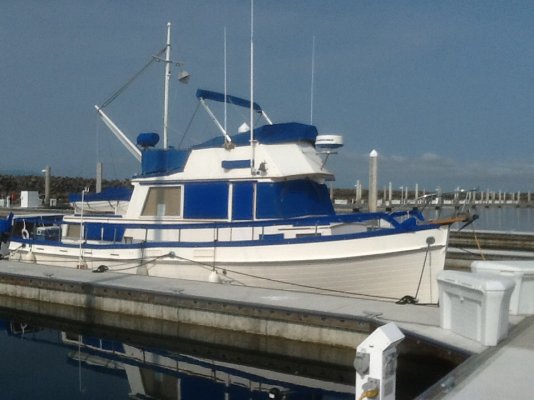"Originally Posted by Chris Foster View Post
So I'm curious about how folks here got good at getting their boats back into the slip.
It seems that all of the printed material and books out there concern getting single engine boats alongside docks using spring lines.* There doesn't seem to be much of anything about getting twin engine boats into slips beyond "center the rudder and use the shifters."
I agree practice is key BUT - you have to know what to practice and how you should be doing it... kinda like golf - if you don't know how to correctly swing the club all the practice at the driving range will likely only perpetuate bad practices.
So key in my mind are:
- Learn about how your type of boat handles (single, twin, thrusters etc) by reading, looking at videos online and talking to others w/ similar type of boats that seem to be doing it well - go with them on their boat and ask them to explain what they are doing and WHY.
You should be familiar with things like...
* where is the pivot point when turning? going fwd? going Rev?
* how much prop walk & what direction do I get in rev? in Fwd?
w/ single or for each engine when using only one
- Then go practice w/ your boat - in open water - to get a feel for how it handles when trying the things you've learned you should be doing.
Get familiar with your boat...
* where is the pivot point when turning? going fwd? going Rev?
* how much prop walk & what direction do I get in rev? in Fwd?
w/ single or for each engine when using only one
- Get someone experienced to come aboard your boat to observe and later offer constructive comments / suggestions.
Repeat above to improve!
I absolutely agree having a plan and communication are key -
2bucks in post #29 summarized the communication issues extremely well - know your limitations and develop ways to compensate for the "weaknesses"
also have a plan B - if / when that doesn't work what are we going to do. I strongly recommend the "pull out" get time to regroup, replan & communicate is not done frequently enough.
Talking an runabouts & smaller boats is probably OK - hand signals are probably req'd on larger vessels and we have and sometimes use headsets that allow 2 way communication without yelling, screaming etc. they are not all that expensive and if you are learning a great way to reinforce the right moves and "gently" correct improper ones.
Sometimes watching what others do wrong is a great learning experience - Admiral & I have sat & watched other teams lock and/or dock and observed what happens when one crew member fends off from bow or stern thinking they are doing the right things but never sees the big picture where the reaction swings the other end of the boat uncontrollably and to the point the Capt had a hard time or couldn't compensate. Having my admiral observe "from afar" & comment about the reaction was more valuable than anything I could have said or done.
My Rules agreed to W/ the Admiral (& any other crew aboard)
- Have lines attached ahead of time when coming in to a dock even if you have permanent ones secured to the dock that you use - if something goes wrong you can toss a line to someone ashore.
- No one jumps off to dock / shore etc - wait until Capt gets the boat close enough to step off - or stand by and wait
- No hands, legs or body parts between boat & dock, etc - scratches & dings come with the territory and are not the end of the world - paint, gel coat etc can be repaired - no damage to bodies!!
- Capt responsible to Communicate the plan & test for understanding - if it's not done correctly it's the Capt's fault - either didn't communicate well enough or didn't train well enough ahead of time
- If others are on the dock assisting be clear ahead of time what you want them to do AND not to do - and who (capt or mate, etc) will be communicating with them
- No yelling, screaming allowed - and it never helps during the situation - calm constructive conversation after is allowed and encouraged
Finally thoughts on spring lines... when docking
We have one permanently attached to our dock and it's the first line to go over a cleat - don't worry about fully attaching it the correct way to the cleat - just drop it over - and if someone is on the dock to help we instruct them to put that line on the mid cleat. We are now attached to the dock... We can pull us closer - others can pull us closer if needed and it keeps us from backing in too far and it brings us closer to the dock automatically.
- I have yet to throw a spring line to someone ashore and have them do with it what I would like done - they don't know my plan and may not have any idea what it is even supposed to do so... I prefer to throw someone ashore the eye end of a line and instruct them which cleat to place it around - I then - myself or trained crew - can use the spring as we have discussed / planed and can agree to abort if/when necessary
 After a year we are no where near being coordinated enough to use a spring line to get into a tight space.
After a year we are no where near being coordinated enough to use a spring line to get into a tight space.


